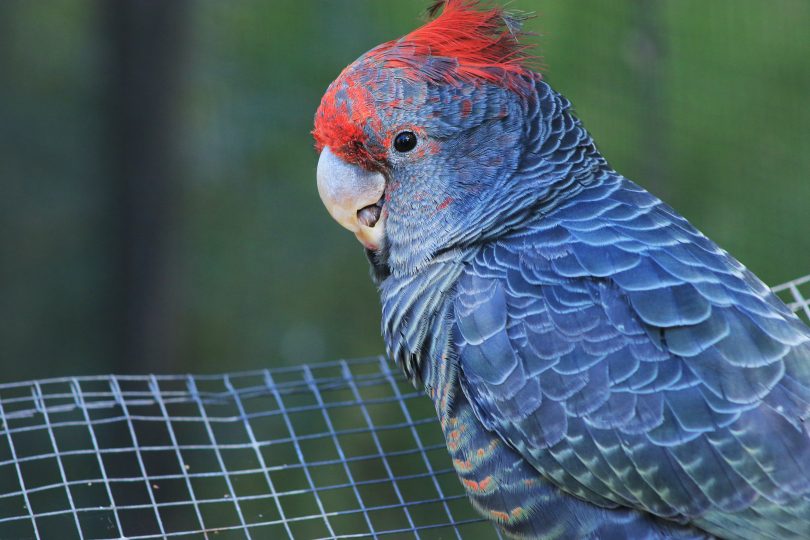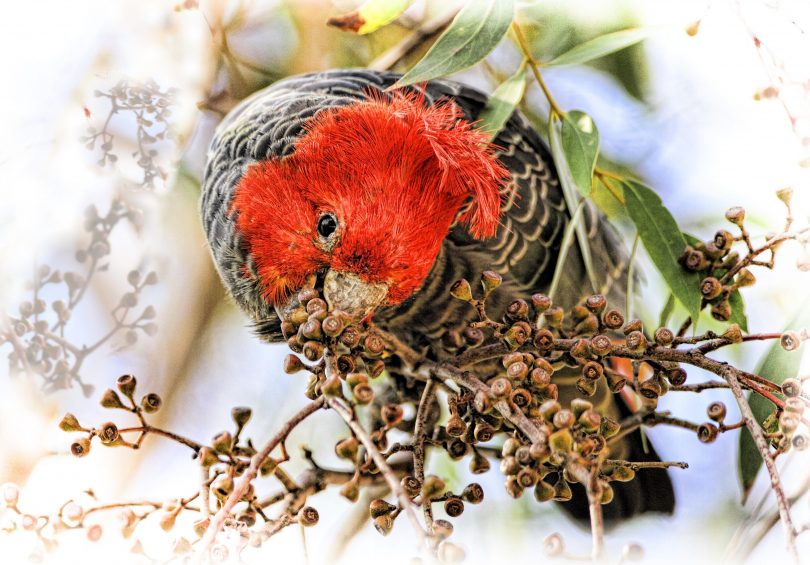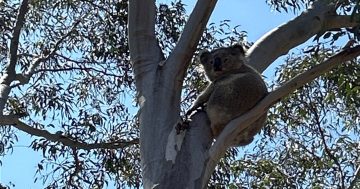
The gang-gang cockatoo is an occasional visitor to Canberra backyards. Photo: Dalal Nizam.
With it’s slate-grey body and bright red head, Canberra is the only city in Australia the gang-gang cockatoo chooses to call home. But there are concerns its numbers elsewhere are dwindling.
The population of the native bird has been relatively stable in the ACT region for the past 30 years, but the rest of southeast Australia has seen a 69 per cent decline in its reporting rate, according to the Canberra Nature Map.
The gang-gang cockatoo (Callocephalon fimbriatum) has been listed as endangered under the Environment Protection and Biodiversity Conservation (EPBC) Act, and the ACT Government’s Environment Planning and Sustainable Development Directorate will be running a citizen survey to record its whereabouts.
The directorate says the Black Summer bushfires had a severe impact on gang-gang cockatoo habitat across the region.
The surveys will cover the last two weekends of September and first weekend of October, 2021, and aim to identify areas of high gang-gang cockatoo occupancy and gain a better understanding of their breeding locations and habitat needs.
Community members can register to participate here.
The gang-gang cockatoo was adopted as the ACT’s fauna emblem on 27 February, 1997, and also features on the logo of the ACT Parks and Conservation Service.

Gang-gangs cockatoos feed on native berries and pine cones. Photo: Geoffrey Dabb.
During winter, small flocks of the birds are common in gardens around Canberra where they feed on pine cones, firethorn and hawthorn berries. They are often so busy feeding that observers can get close enough to admire their beautiful plumage.
In summer, most of the flocks return to the mountain forests to breed in tree hollows.
Their call is a distinctive sound resembling a squeaking gate.
Canberra naturalist Ian Fraser says the gang-gang cockatoo has been categorised as vulnerable in NSW for some time, although its situation is considered less dire here in the ACT.
“The 2019 bushfires definitely would have affected a lot of their breeding habitats in the mountains,” he says. “But the fact they’re in trouble is not just to do with that.”
Ian says it’s hard to put a finger on why certain species decline in numbers, but for cockatoos, logging certainly shares part of the blame.
“My feeling is that, as with other cockatoos, the real trouble is the progressive loss of breeding trees,” says Ian. “Fires will have exacerbated that, but the real problem has been the logging of forests over many, many decades.
“Cockatoos, in particular, need hollows in tree trunks to make their nests. This typically requires 200-year-old eucalypts, which are most often the very ones that are coming down.”

The Orroral Valley in December 2020, almost 12 months on from the devastating Black Summer bushfire. Photo: ACT Parks and Conservation Service.
‘Threatened’ is a general term comprising categories ‘endangered’, being the second-highest one, and below it, ‘critically endangered’.
“It’s all defined in legislation in terms of during how many generations there has been a decline and how many generations can we expect before it will disappear,” says Ian.
“I wouldn’t say gang-gangs are threatened, but they are certainly vulnerable, which means if things don’t change, they will become threatened.”
In regards to other species affected by the Black Summer bushfires, Ian says, “We really don’t know about all of them.”
In 2020, Birdlife Australia reported that 180 million birds were impacted by the 2019-2020 bushfires, with 17 species identified as being in urgent need of management.
Ian says it’s the smaller species that can fall by the wayside when it comes to tracking their numbers.
“There’s never enough resources to do the sort of intensive studies that are needed to follow populations over years,” he says. “It’s really too early to say what effect the bushfires had on native fauna.”
“My own sick feeling is that the next Australian bird to become extinct could well be the regent honeyeater. It’s dwindling in numbers; we’re probably down to less than a couple of hundred birds left now scattered the full length of the east coast and hinterland.”
The regent honeyeater is currently classified as endangered in the ACT, and critically endangered in NSW.
“There’s a huge amount of work that’s gone into habitat planting and doing what seems to be the reasonable things to do to protect them, but numbers just keep dropping.”
Original Article published by James Coleman on The RiotACT.





